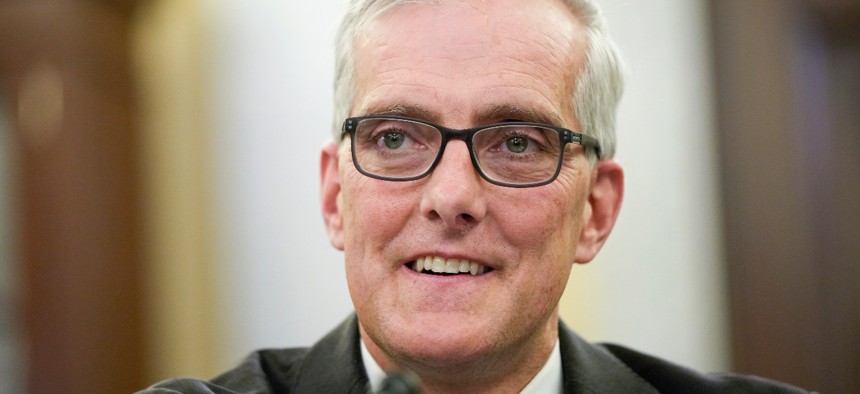
Secretary of Veterans Affairs Denis McDonough said the reforms are already paying off with improvements in hiring. Drew Angerer/Getty Images
The VA Gives Raises to 10,000 Nurses, Takes More Steps to Boost Recruiting and Retention
The department is looking to quickly implement a new suite of incentives aimed at making VA a more attractive place to work.
The Veterans Affairs Department is racing to implement a slew of new authorities Congress provided it earlier this year to improve pay, bonuses and benefits for employees in the hopes of recruiting more employees and keeping existing ones.
Many of the reforms stem from the Honoring our Promise to Address Comprehensive Toxics (PACT) Act, which newly presumes, for the purposes of eligibility for care and benefits from the VA, that 23 respiratory illnesses contracted by veterans are related to burn pits used in the military. Advocates and employee groups have warned the new workload—coupled with existing shortfalls stemming from the pandemic and other issues—could leave veterans with insufficient or untimely care due to understaffing, but VA Secretary Denis McDonough on Tuesday told reporters he remained confident his department would be up for the challenge.
VA's human capital staff began identifying the steps the department would have to take to implement the PACT Act’s workforce provisions since Congress first began developing it, Gina Grosso, VA’s undersecretary for human resources, said at the briefing. So far, VA has already codified, or entered the final stages of codifying, half of those reforms. Those have included limiting veterans preference for housekeeping aides to make it quicker to bring on applicants, raising the cap on bonuses without requiring a waiver from the Office of Personnel Management from $10,000 to $25,000, hiring more recent graduates on an expedited basis and increasing its maximum student loan repayment from $60,000 to $100,000. Those policies have all been sent out into the field, officials said on Tuesday, but the department does not yet have data on their usage.
“This legislation provides a broad range of recruiting and retention authorities that will allow the VA to recruit and retain the workforce we need to provide the care and benefits to the nation's veterans, their caregivers and survivors,” Grosso said.
VA has also begun implementing the Retention and Income Security Enhancement (RAISE) Act, which President Biden signed into law in March as part of the omnibus funding package. That has led to VA approving pay increases for nearly 10,000 nurses, raising their salaries to a new cap of $203,000 per year. Any nurse at the previous cap, or within 10% of it and working in certain markets, automatically saw a pay increase. Jessica Bonjorni, the chief of human capital management at the Veterans Health Administration, said the PACT Act has allowed the department to offer bigger bonuses and awards to employees, as well as recruitment, retention and relocation incentives of up to 50% of employees' salaries. The retention payments will now be paid in an up-front lump sum.
VA will finalize policies involving boosted pay for employees with critical skills and others, such as those providing care to burn pit victims, by the end of the year. McDonough previously implemented initiatives to boost eligibility for child care subsidies, increase retention incentives and create new career paths that will lead to more opportunities for promotions and raises. In addition to VA’s own student loan repayment program—which requires beneficiaries to commit to at least three more years of service—it has proactively reached out to employees to help them enroll in the expanded Public Service Loan Forgiveness Program. With the deadline to get a waiver into the program approaching at the end of the month, VA has helped 2,500 employees this month and 26,000 employees this year apply for the loan forgiveness.
The secretary said taken in totality, the reforms are already paying dividends. VA saw a net increase of 2,042 registered nurses in fiscal 2022, which McDonough called a “big accomplishment during this tight market.” The department has worked aggressively to market all of its new benefits, including through partnerships with veteran service organizations. Aaron Lee, the head of human capital services at the Veterans Benefits Administration, said his component used to receive a few hundred applicants for each posting for benefits processors. It is now receiving between 3,000 and 5,000 applicants for each opening. Lee called the influx of interest challenging, but a “good problem to have.” The Veterans Benefits Administration has successfully filled more than 2,000 positions for toxic exposure claims processors and has upped its claims processing compared to last year by 19%.
VA is also working to hire employees more quickly and nearly every VA facility is holding an “onboarding surge event” the week of Nov. 14 to help meet hiring goals. Bonjorni said a "tiger team" is currently working on ways to improve the onboarding process in the long term, including by eliminating steps like the requirement for all employees to take a physical.
The department’s new workload will begin soon. Starting Nov. 8, every veteran seeing their primary care physician at VA will go through a five-minute screening process to assess their potential eligibility for care and benefits related to burn pit exposure.







